小学剑桥英语小学三年级起点英语上册
外研剑桥版三年级英语上册全一册教案(全英文)
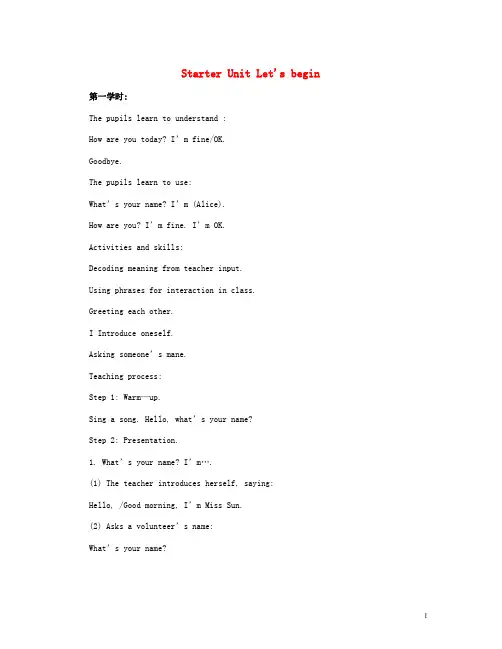
Starter Unit Let's begin 第一学时:The pupils learn to understand :How are you today? I’m fine/OK.Goodbye.The pupils learn to use:What’s your name? I’m (Alice).How are you? I’m fine. I’m OK.Activities and skills:Decoding meaning from teacher input.Using phrases for interaction in class.Greeting each other.I Introduce oneself.Asking someone’s mane.Teaching process:Step 1: Warm—up.Sing a song. Hello, what’s your name?Step 2: Presentation.1. What’s your name? I’m….(1) The teacher introduces herself, saying:Hello, /Good morning, I’m Miss Sun.(2) Asks a volunteer’s name:What’s your name?The teacher prompt the pupil by whispering, I’m (Alice). (3) Asks all the pupils the same question and help those who needit by whisperin g I’m….2. How are you today? I’m fine. I’m OK.(1) The teacher explains the meaning of How are you today? (2) Tell the class to ask the question all together and introducetwo answers, I’m (not very) fine/I’m Ok.(3) Asks all the pupils the same question and make sure that allthe students can reply.Step3: Speak English in class.1.Tells the pupils to open their books at page3, look at the fourphotographs, and listen to the tape.2.Asks the pupils to dramatise the situations depicted in the fourphotographs. A volunteer will play the part of the parts of theother pupils, answering as a group.第二学时:The pupils learn to use these new words:Sandwich, hamburger, hot dog, puller, cowboy, jeans, cinema,walkman, snack bar, Taxi, clown, superstar.Activities and skills:Singing the song and colouring picture frames.Teaching process:Step 1:Warm—up:Greetings:(1) Good morning!(2) I’m Miss Sun. What’s your name?I’m (Alice, John…).(3) How are you today?I’m fine/OK.Step 2:New words.1. Learn to say these words one by one using flash cards.2. Guessing game.Is it a cowboy/snack bar…?No, it isn’t. Yes, it is.3. Read them following teacher.4. Colour the frames.(1)Open book at page4, take your colour pens. Listen and colour.(2)Colour your (hamburger, orange…).(3)Let’s check.The hamburger is orange.Step 3: Sing the song.1. Listen to the tape.2. Teacher sing the words.3. Learn to say the words.4. Let’s sing it one sentence by one sentence.5. Sing the song and do the actions together.Step 4: Say good—bye.Goodbye, children.Goodbye, Miss Sun. See you next time.第三学时:The pupils learn to understand:Watch me. Stretch. Clap your hands. Stand back to back.Stand nose to nose. Stand arm in arm.The pupils learn to use:Good morning./Morning. Good afternoon. Good evening.Good night.Activities and skills:Carrying out action story.Listening to the tape and filling numbers.Teaching process:Step 1: Warm—up(1) Greetings.(2) Play guessing game with flash cards. (3) Sing the song: English is easy.Step 2: Mime the action story.1.The teacher and the pupils listen to the instructions on thecassette. The teacher performs each action and the pupils watchand then imitate the teacher.Repeat this stage several times.2.The teacher gives the instructions in the same order which the pupils heard them on the cassette during Phase 1. The pupilslisten and do the actions one at a time, following the teacher’sinstructions.3.The teacher gives the instructions in jumbled order. The pupilslisten and performs the actions one at a time.Step 3:Listen and fill in the numbers.(1) Listen and mime.(2) Fill in the numbers.(3) Check it. Make sure that everyone is correct.Step 4: Learn to say.The teacher draw a clock on blackboard. When it is 7:30, says“Good morning” or “Morning” to the pupils. The pupils answer “Good morning” or “Morning”.“Good afternoon”, “Good evening” and “Good night” are thesame above.第四学时:The pupils learn to use :How are you? I’m fine/very well/OK.Thank you. And you?Nice to meet you. Nice to meet you, too.Activities and skills:Speaking and comprehension:Teaching process:Step1: Warm—up.1. Greetings.Good morning. /Morning.Good afternoon.2. Sing a song: Join in.Step 2: Let’s read and act.1. T: Hello, I’m Miss Sun. What’s your name?S: Hi, I’m Alice.T: Nice to meet you.Tell the student that he or she should say “Nice to meet you, too.” Have this conversation with others, and make sure that all the pupils can say it correctly.2. Other sentences just to be taught and learnt like those above.3. Actions:(1). Pair work: Two pupils to act the conversations.(2). Boys and girls competition.Step 3: The end.Goodbye, children.Goodbye, Miss Sun.Unit 1 Numbers第一学时:The pupils learn to understand:The tiger jump.Do the numbers rock.The pupils learn to say:Numbers 1—12.Twelve o’clock; do the numbers rock.Yippee!Let’s do the tiger jump.Your turn.Activities and skills:Singing the song: The numbers rock.Saying the chant : The tiger jump.Colouring the numbers.Listening to conversations and matching the names of childrenwith numbers on dice.Playing two number games.Teaching process:Step 1: Warm—up.1. Count numbers from 1 to 10.2. Sing the song. Hop.Step 2: Listen and sing the song. The numbers rock. 1. Learn to say:11 eleven, 12 twelve. Twelve o’clock.2. Listen and say the chant.Step 3: Listen and say the chant.1. The teacher says the chant and performances in the sameorder, the pupils follow.2. Teacher says, pupils do in the same order.3. The teacher says and pupilsdo in the jumbled order. 4. Listen to the tape and say the chant, do the actions.Step 4: Colour the numbers.1. Show numbers’ cards 1—12 to the pupils. Count them.2. Open book at page9, match numbers with the words.3. Colour them and check them.Step 5: Listen and match.1. Teacher writes numbers on the blackboard. The pupils readthem.For example: 3 6, 1 5, 4 5, etc.2. Listen and match then check.3. learn to say “Your turn.”4. Play the game in class.第二学时:The pupils learn to understand:What’s in the box?Guess the number.Super prize!Come on, (Fred).Here is your prize, Emma.Thank you, Emma.Great!The pupils learn to use:What’s in the box?Snails! Yuk!How many?Activities and skills,Listening to and un derstanding a story. Playing game: “Guess the number.” Teaching process:Step 1: Warm—up.1. Say the chant : The tiger jump.2. Sing the song: The numbers rock.Step 2: A game. Guess the number.1. Count numbers 1—12.2. Shows the pupils numbers’ ca rds, guess the number.3. Take a box, put some glass balls in it. Shows them a glassball, asks:What’s this? What’s in the box? How many? If the pupils are right, says “Great! Here is your prize.” And givethem a glass ball.Step 3: A story. The snails.1. Teacher says, You will hear a story. The snails. Please listencarefully.2. Listen to the tape several times.3. Make sure that the pupils fully understand the meaning of thisstory.4. Play this game in class.第三学时:The pupils learn to understand:Guess the number.The pupils learn to use:Twelve is two plus ten, now let’s start again.How many?Yes. / No.Activities and skills:Saying the rhyme.Playing two number games.Teaching process:Step 1: Warm—up.Sing the song. The numbers rock.Step 2: Listen and say the rhyme.1. Count numbers 1—12.2. Read the words line by line several times.3. listen to the tape, say the rhyme.4. Asks a group of 6-7 pupils stand in a circle, and say the rhyme, see who is left out.Step 3: Play a game.1. Teacher asks a pupil to come to the front of the class anddemonstrate the game as shown in the first two pictures.2. Play in pairs and proceed in the same way for the second game.3. Play this game one by one.第四学时:The pupils learn to understand and use:What’s your phone number?Activities and skills:Listening and taking notes of phone numbers and saying whatthey are.Asking other pupils for their phone numbers and taking notes.Teaching process:Step1: Warm—up.1. Count numbers 1—12.2. Say the rhyme.Step 2: Listen and write the phone numbers.1. Draw a big telephone on the board. Introduce the word Phoneor telephone immediately followed by the sentence My phonenumber is ….2. Listen and write.Tell the pupils that they are going to hear some recorded interviews, and that they have to listen and discover the telephonenumbers of a few children.Read the names of the children out loud and ask the pupils torepeat them.Listen to the tape several times and write.3. Let’s check.Step 3: Write your phone numbers.1. The pupils write their phone number. Tell them how to readthe number.2. Read your number yourself.Step 4: Asks children’s phone number.1. Teacher asks, What’s y our phone number? A volunteer answers, other pupils write down.2. Work in pairs.3. The pupils ask and answer each other, and write.4. Let’s check.Teaching aims:1. Learn to say:How many girls/boys/flags…can you see?Let me count. I can see….2. Learn to say:What is (seven) plus (twelve)?What is (eleven) minas (nine)?3. Write the numbers 1—12.Teaching process:Step 1: A game.Prepare a box which is full of glass balls. Shows them the box, and asks, what’s in it? Let pupil guess, and t hen someone touchesit. (Glass balls.)How many? How many glass balls ? How many glass balls canyou see? Count, please. The pupil counts. One, two, three, four…Step 2: Learn to say.1. Teacher chooses a group of pupils, and asks, how many girlscan you see? Tells them to reply, let me count. And then, count.One, two,….Tells them to say, I can see…2. Repeat this exercise several times.3. Ask and answer with other words which they learned, such asboys, flags, dogs…Step 3: Learn to say.1. Write those below on the blackboard:7+5 8+2 11-96+4 12-9 2+2Point a pupil to read them.2. The teacher asks What is 7 plus 5,Make sure that each pupil can reply“It’s…” correctly.3. Pupils open book at page 15, work in pairs.Some pairs of pupils wok in class.Step 4: Complete the word puzzle.1. Show the pupils flashcards of numbers 1—12. Read them, and spell the words.2. Open book at page 15, complete the 14th exercise.3. Check it.Unit 2 Colours第一学时:The pupils learn to understand:What colour is this/The pupils learn to use:Colours: red, orange, yellow, green, blue, purple, pink, black, white.I like (green) and (red); I like orange, too.Oh, what a rainbow!Activities and skills:Listening to words and pointing at the appropriate pictures in the box.Sing a song.Teaching process:Step 1: warm—up.1. Greetings.Good morning. / Good afternoon.2. Sing a song. Butterfly.Step 2: Listen and point—presentation.1. Introduce the following colours: red, orange, yellow, green, blue, purple, pink, white and black.Show the pupils colours with the help of coloured flash cards and objects in the classroom,2. Say the words.(1) Show a colour and say the word several times, then ask the pupils to repeat it.(2) Name a colour and ask the pupils to touch something of that colour.3. A game.(1) Teacher names a colour, four pupils touch an object of the correct colour. The last pupil is “out”. The winner is the person who touches the correct one first.(2) Asks of the pupils to take over the role of the teacher.(3) Proceed in the same way for the other remaining colours.Step 3: Listen and point.Open their book at page 16, listen to the tape carefully, point the corresponding colour.Step 4: Listen and sing s song. Rainbow.1. Draw a picture of a rainbow on the board and introduce the word Rainbow.2. Listen to the word and repeat it.3. Sing the song following the tape.第二学时:The pupils learn to understand:1. What colour is (the wizard’s house)?2. I’m from Italy; (Great Britain; Argentina; Brazil).The pupils learn to use:I’m (Lucia). I’m from China. This is my flag.Activities and skills:Finding out from a lis tening text what colour the wizard’s houseis (listening for detail).第三学时:The pupils learn to understand:Help.Open the door.The pupils learn to use:(Green), please. Here you are.Good night! Good morning!What’s this? Wow!Activities and skills:Listening to and understanding a story.Teaching process:Step 1: Warm—up.1. Sing a song. The rainbow.2. (1) Teacher walks around the classroom asking the pupils:Blue, please. Green, please, etc.The pupils should gives me an coloured pencil requested. (2) Do the same exercise by the pupils in pairs.Step 2: The story.1. Introduce and practise new vocabulary.Here you are. Help. Open the door. What’s this? 2. Pupils listen to the text two or three times with their booksclosed and try to imagine what is happening from the tone of thevoices and blackboard noises.3. Pupils listen two or three times with their books open.4. Pupils listen one more time with their eyes closed and try toimagine what they saw in the text.Step 3: Act out the story.Two pupils for wizards, somebody to make the noises of boilingwater, and explosion, coloured bottles.第四学时:The pupils learn to understand:What’s my favourite colour? Is it (blue)?What’s your favourite colour?Yes, that’s right.The pupils learn to use:Guess.What’s my favourite colour? Is it (blue)?What’s your favourite colour?Yes, that’s ri ght.Activities and skills:Playing a game based on the principle of information gap.Completing dialogues in writing.Listening to a chant and circling patches of colour.Saying a chant.Doing a crossword puzzle.Teaching process:Step 1: Play a guessing game.1. Ask a pupil to touch a part of the coloured fish.The teacher can’t see what colour the pupil is touching and,naming several different colours, should try to guess.2. Once the pupils have understand the way game works, they can play in pairs and exchange roles.Step 2: Complete the dialogues.1. Learn to write the words and sentence:Green, blue, white, please.Here you are.2. Ask the pupils to look carefully at the four scenes and tocomplete the dialogues according to what they see in the pictures.Step 3: A chant.1. The pupils should listen to the chant once all the way through.2. Then they listen a second time, but this time the tape shouldbe stopped after each question to give the pupils time to circle the colour.3. Finally they listen a third time to check the answers.The teacher should check that the pupils have understood and askwhich colours they have circled. The pupils say the colours in the correct order.4. The teacher writes them on the blackboard. The pupils copy the words.5. Repeat the chant in two separate groups.第五学时:The pupils learnt to understand:What about you?What about this?What’s that over there?The pupils learn to use:I’m from (America).I like (red) best.What’s your favourite colour?What colour do you like?Activities and skills:Speaking those sentences in groups.Talking about the birthplace and the favourite colours ofthemselves.Teaching process:Step1: Warm—up1. Say the chant: what’s your favourite colour?2. Revise the words: Great Britain, Italy, Brazil, Argentina. I’m fr om China.Step 2: Let’s learn and work in groups.1. Introduce new words.America, England, Canada, best, about.2. Learn to say.I’m….I’m from….I like (red) best.3. Introduce how to use “what about you?”. Make sure thateveryone has understood it.4. Read the sentences.Step 3: Work in the groups.1. Pair work.2. Teacher and student act in class.3. Work in tablemates as the model.Step 4: Let’s talk.1. Introduce new words: jeep, over there.ing some flashcards, ask and answer. T: What’s this? (A car.)S: It’s a car.T: What colour is it?S: It’s (red).And tell the volunteer to say: It’s a Chinese car. All the classrepeat it.The teacher shows them another flashcard, and asks: What aboutthis?Make sure that the student can answer it correctly. 3. Talk about the flashcards in pairs.4. Let’s talk in class.Unit 3 School things第一学时:The pupils learn to understand:What colour is the wizard’s schoolbag,The pupils learn to use:Pen, pencil, pencil case, schoolbag, ruler, eraser, book..Activities and skills:Listening to the words on the tape and filling in the numbers in the book.Listening to the tape and finding out what colour the wizard’s schoolbag is.Teaching process:Step1: Warm--up.1. Show pupils some school things, such as:pencil, book, pen, schoolbag, pencil case. Ask pupils: What’s this? It’s a (pen).2.A game Toby says:Touch your (pen). Take your (book).Step2: Listen and fill in the numbers.1. Introduce the new vocabulary using realia, rule, eraser,2. The pupils open their books at Page 24.The teacher reads the words, first in the order in which they are presented and then in jumbled order, ask the pupils to point to the corresponding picture.3. Listen and fill in the numbers.(1) The first time, the pupils listen to the tape without interruptions for general do the exercise by themselves.(2) The second time, the pupils listen to the tape without interruptions so that everybody can do the exercise.Check the answer. Name the objects and ask the pupils to answerwith the corresponding numbers.Step3. Listen. What colour is the wizards schoolbag.1.Tell the pupils in Chinese that they have to discover the colour of the wizards schoolbag.2.Give them an example.The pupils point to the word start, the teacher says blue and the pupils pointto the blue square. Then say ruder and the pupils touch the ruder.Proceed in this way from ruder to yellow, and then to pencil to blue to eraser.At this point ask What colour is the wizards schoolbag? (Blue).3.Listen to the tape and follow the sequence of squares using a pencil.4.Listen two or three times to check the answer.第二学时:The pupils learn to understand:Open your (schoolbag).Take out (a ruler).Take out (two books).W hat’s this? A skipping rope.Hooray!The pupils learn to use:Three pens, four pencils, two books.Activities and skills:Understanding instructions and miming actions.Listening to the tape and filling in numbers.Teaching process:Step 1: Warm—up.Ask and answer.Show the pupils a ruler, a pen ,a schoolbag, two erasers, four books, three pencils.Ask: What’s this? What colour is it? How many books can yousee? Etc.Step 2: New word.Show them a skipping rope and teach the new word.Step 3: Mime the action story.1.The teacher and the pupils listen to the instructions on the cassette. The teacher performs each action and the pupils watch and then imitate the teacher.Repeat this stage several times.2.The teacher gives the instructions in the same order which the pupils heard them on the cassette during Phase 1. The pupils listen and do the actions one at a time, following the teacher’s instructions.3.The teacher gives the instructions in jumbled order. The pupils listen and performs the actions one at a time.Step 4:Listen and fill in the numbers.(4) Listen and mime.(5) Fill in the numbers.(6) Check it. Make sure that everyone is correct.第三学时:The pupils learn to understand:How many (red) things are there?The pupils learn to use:Two pens, three erasers, four pens, five rulers.Activities and skills:Reading what is in the picture and colour frames around word groups in the appropriate colour.Counting school things in a picture puzzle.Teaching process:Step1: Warm—up.A guessing game.1. Show the pupils a box which is full of pens, pencils, rulers, erasers, and books. And ask the pupils to guess how many pens/ pencils/ rulers/erasers/books are there?T: Guess! How many (pens)?2. When the pupils guess correctly, ask them: What colou arethe (two pens)?Step 2: Read and colour the frames.1. Introduce how to do the exercise.Point out to the pupils that there are 10 pictures and only five boxes on the right. The pupils have to colour the frames of the boxes on the right following the example. The frame of the box containing the words two pens, is orange like the two pens in the drawing.2. The pupils colour the frames themselves.3. Check the answer.Ask the pupils to say which colours match which words.Step3: Count and write the numbers.1. Read the sentences several times. And translate the questions.2. Thepupils write exercise in the book.3. Check the answer.Ask the question and the pupils answer orally.第四课时 :Teaching aim And demand:1.The pupils learn to understand:Stop it.Come here, Timmy.Help me, please.Where’s my pencil case?It’s not here.I’ve got it!2.Acticities and skills:Decoding the meaning of the language in a story. Important and Difficult front: Understand the sentences of the story.Teaching process:Step 1:Warming-up1.Sing an English song: Join in.2.Revise the school thing. Which have learnt in this unit.3.Revise the sentence: Here is your prize. Here is my prize.Step 2 : Presentation1.Listen to the story.2.Ask the students to open their books at page 28.3.Ask them listen to the tape, listen to an English story.4.Ask the students to tell the meaning of the story.Step 3 : Learn to understand the sentences.1.Ask some students do a action, then say: Stop it, xxx.” Let the students tell the meaning of the sentence. Then practise it.2.Pretend to find something, and say: Where’s my pen?” Ask the students to say what am I doing. And tell the meaning of the sentence.3.Ask someone xxx, help me, please.” Let him/her find things with me. Then ask them to tell the meaning of the sentence.4.Practise the two Sentences in pairs.5.Say:It’s not here,” while finding the thing. Let them say the meaning of the sentence. Then practise it.6.Wh en finding the thing, say: I’ve got it!” Let the students tell the meaning of the sentence. then practise to say it.Step 4 : Consolidation1.Listen again and say the sentences after the tape.2.Perform the story in the class.第五学时 :Teaching aim And demand:1.The pupils learn to use:How many desks are there?What about Chairs?How many pens have you got?2.Activities and skills:Let’s read.Let’s work in groups.Important and difficult point: Read the conversation.Teaching process:Step 1 : Revision1.Sing an English song: In our classroom.2.Show some pictures to the students and ask them to read it. (desks). (chairs).3.Revise the colours.4.Revise the sentences. Which they have leamed in previous class.5.Spell the words.Step 2 : PresentationA: Learn to say the conversation.1.Show a picture to the students.2.Ask them How many desks are there”?3.Ask: What about Chairs? How many charis are there?”4.Show some other things to the student, practise to the sentence Howmany(desks) are there?”5.Read the conversation to the students, ask them to tell me the meaning of the conversation.6.Read the conversation after the teacher several times. Then practise by themselves in pairs, until they can read it correctly.7.Ask someone to perform the conversation in the front of the classroom.Step 3 : Play a game and do the group work.1.Send something to the students.2.Ask them one by one: How many pens have you got?” Answer the question in stead of the students. Then ask them to tell me the meaning of the sentence.3.Ask them to read the sentence after the teacher several times.4.Practise the sentence by themselves, until they can read itcorrectly.5.Do the group work.第六学时 (12. Revision)Teaching aim And demand:1.The pupils learn to read the sentences:I have got (a small room).It’s (nice) and (clean).There is (a bed) (in my room).There is (a computer) (on the desk).I often work at the desk.2.Activitise and skills: Read the text.Important and difficult point:Can read the text of the lesson.Teaching process:Step 1 :Revision1.Sing an English song.2.Spell and read the words:pencil, pencil case, pen, book, eraser, ruler, schoolbag. 3.Look the pictures and say.Two pencils two blue pencils ect.5.Ask and answer:How many pencils are there?How many blue things are there?How many pens have you got?Step 2 :PresentationA : Look at the pictures, learn to say the new words. 1.Point the thing and say the English of it.2.Ask the students to read the word after the teacher. (bedcomputer)3.Practise to say the words by themselves, and then say outloudly, until they can red it correctly.B : Look at the picture again. Ask and answer:Where is the (bed),1.Ask the students to look at the picture and answer: Where is thebed?2.Answer in stead of the students: It’s in the room.e the same way to teach:It’s by the window.It’s on the desk.Step 3: Learn to say the text.1.Look at the picture and listen to the teacher read the text.2.Ask them to tell the meaning of the text.3.Read the text after the teacher several times.4.Practise to read the text by themselves, until they can read itcorrectly.5.Ask someone to point the picture and say the text.Unit 4 Pets第一学时:Teaching aim And demand:1.The pupils learn to use:What have you got?Have you got a pet? Yes, I have.2.Learn to use the words:Cat dog mouse fish budgie, rabbit. Hamster.3.Activitise and skills:Saying a chantListening to a cass ette and finding out what the wizard’s pet is. Important and difficult point:pictures, radio and tape.Teaching process:REVISION:1.Sing an English song: join in.2.Conversation:What’s your favourite colour?What colour is the schoolbag? ect.PRESENTATION:A: Learn to say the six new words.1.Learn to say the word: cat.Show a picture of a cat to the stuelerts, tell them: This is a cat.” Ask them to read the word after the teacher several times. Thenpractise by themselves, until they can read the word correctly.e the same way to teach the other words: dog, mouse, fish,budgie, rabbit.3.Fun time.Listen to the sound of these animals or mine these animals. Askthe students to say the words and at the same time point to thecorresponding flashcard.B: Learn to say the sentences.1.Learn to say the sentence: Have you got a pet?Pretend to need a pen and ask a pupil: Have you got a pen? Ifnecessary translate the sentence.2.Read the sentence after the teacher several times.3.Practise the sentence by themselves:Use the flashcard and ask the students:Have you got a (hamster)? And then answer “Yes.” And thenask the students to ask the teacher answer.e the same way to teach:What have you got?C: Listen and say the chant.Play the chant two or three times and ask the pupils to repeat it, until they can read it correctly.D: Listen and find the wizard’s pet.Ask the same way before.BLACKBOARD DESIGN:PetsCat dog mouseFish budgiz rabbitHamster.第二学时 :Teaching aim And demand:1.The pupils learnt to use the sentence:(Linda)’s cat is brown and white.。
外研社剑桥Join in三起点三年级上册Unit1__Hello教学及学习目标
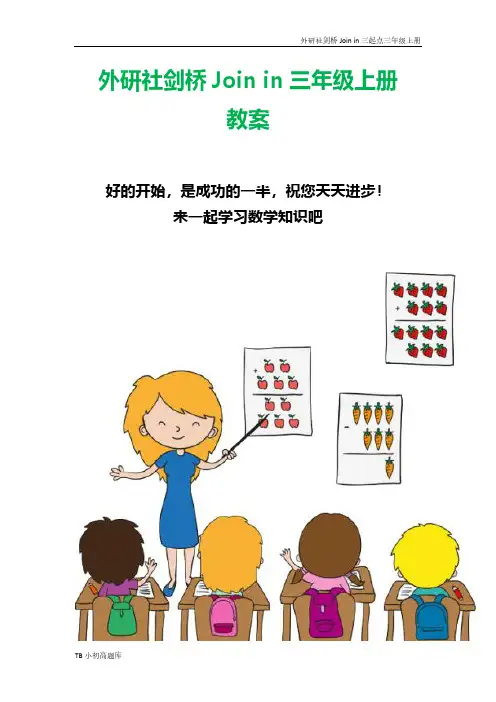
外研社剑桥Join in三年级上册
教案
好的开始,是成功的一半,祝您天天进步!
来一起学习数学知识吧
Uint1 Hello教学及学习目标
1、能正确认读、规范书写字母Aa Bb Cc Dd Ee并能感知字母在单词中的发音。
2、能根据听到的单词apple, bed, cat, dog, egg指认图片或实物,并能根据图片认读单词。
3、能根据指令Stand up. Stretch. Stand back to back. Stand nose to nose. Stand arm in arm. Clap your hands.做动作、给图片标序号。
4、能用Hello相互致以简单的问候。
5、能用What’s your name? I’m…相互交流简单的个人姓名信息。
6、能运用What’s this? My new skateboard.进行简单的交际。
7、能在图片的提示下听懂、读懂小故事Pit’s skateboard. 并能进行简单的角色表演。
8、能学唱英语歌曲Hello! What’s your name? The number song,并作出相应的
动作。
相信自己,就能走向成功的第一步
教师不光要传授知识,还要告诉学生学会生活。
数学思维
可以让他们更理性地看待人生。
2024年秋新剑桥版(三年级起)英语三年级上册课件 Unit 2 第2课时(Story time)
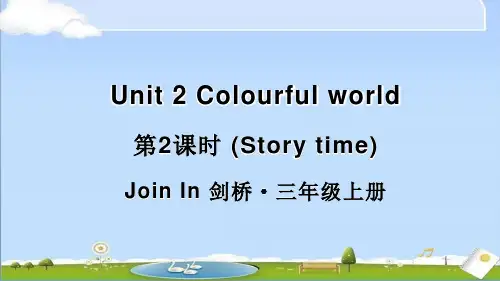
Only white, red, yellow and blue ...
Let me think ...
Red and yellow. Blue and yellow.
It’s orange.
It’s green.
A colourful necklace!
Happy birthday, Mum!
妈妈
A. Mum’s birthday
Nana
B. A gift for mum’s birthday
给
What does Nana want to give her mum? She wants to give her mum a beautiful necklace.
项链
Read and answer
Unit 2 Colourful world
第2课时 (Story time)
Join In 剑桥·三年级上册
Enjoy a song
Look and say What colour is it? It is _y_e_ll_o_w_.
What colour is it? It is _g_r_e_e_n_.
(三原色):
red by these three colours: red, yellow
yellow
blue
and blue.
7 Colour a necklace. Then point and say. IIttI’tI’sst’Is’tsopyg’wbsperurahlier.ulnn.piode.tekglewn.e.e...
What colour is it? It is _b_lu_e_.
What colour is it? It is _r_e_d_.
剑桥三年级上册英语
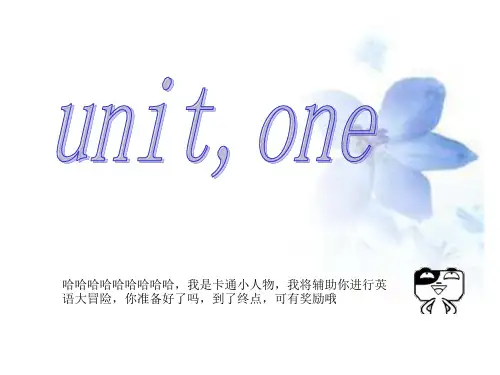
Hello,i’mchen jie.what’your name.
嗨,我是吴一凡。 你好,我是陈洁,你叫什么名字。
my ,name’sarah 我的名字是sarah.
Goodbye! 再见
Bye,miss white. 拜,怀特老师。
பைடு நூலகம்
Hello,i’m miss white 你好,我是怀特老师。
Hi,i’m sarah.
再见,怀特老师。
Zoom! Your bag. Zoom,你的书包 Oh,on! 天啊 bag 书包 pen 钢笔 Pencil box 铅笔盒
Open your pencilbox. 打开你的铅笔盒 Shuw me your pen . 举起你的钢笔。
Close your book.
合上你的书本。
Carry your bag。 背上你的书包。
恭喜你,过关啦,这是给你的礼物,我们下次再见。
嗨,我是sarah. Hello,i’mwu yifan.
不可能,你怎么能够闯过第一关,看来我得小心了, 接招吧!等着瞧吧,你肯定闯不过这一关!
Ihave a ruler 。 我有一个尺子。
I hane an eraser.
我有一个橡皮擦
ruler 尺子
pencil 铅笔
crayon 蜡笔
eraser 橡皮擦
诗 词 大 比 拼
课外链接 a c b 字母歌
放哦 名 几 注 你, 鼎 关 意 过还 鼎 。 啦 去要 的 但 , 。会 字 这 虽 唱母次然 ,歌不你 如吗一闯 果,样过 你知,了 会道你, 唱还说前 我不过面 就行大好
Hello,i’m mike. What ’ your name?
三年级starterunit及unit1
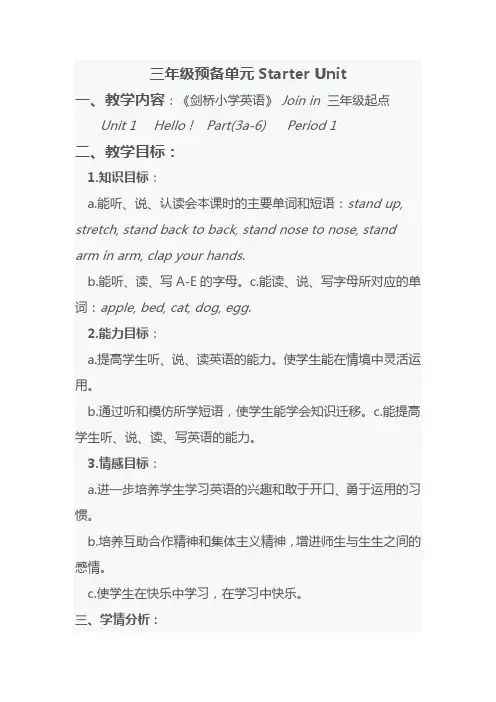
三年级预备单元Starter Unit一、教学内容:《剑桥小学英语》Join in三年级起点Unit 1 Hello ! Part(3a-6) Period 1二、教学目标:1.知识目标:a.能听、说、认读会本课时的主要单词和短语:stand up, stretch, stand back to back, stand nose to nose, stand arm in arm, clap your hands.b.能听、读、写A-E的字母。
c.能读、说、写字母所对应的单词:apple, bed, cat, dog, egg.2.能力目标:a.提高学生听、说、读英语的能力。
使学生能在情境中灵活运用。
b.通过听和模仿所学短语,使学生能学会知识迁移。
c.能提高学生听、说、读、写英语的能力。
3.情感目标:a.进一步培养学生学习英语的兴趣和敢于开口、勇于运用的习惯。
b.培养互助合作精神和集体主义精神,增进师生与生生之间的感情。
c.使学生在快乐中学习,在学习中快乐。
三、学情分析:本节课的主要内容是学习动作故事,学生们对动作短语很感兴趣,喜欢说一说,动一动,做一做,符合他们的心理、身理特点,很乐于学习。
在保持学英语兴趣的同时提高综合语言运用的能力。
四、教学重点:1.能听、说、认读会本课时的主要单词和短语:stand up, stretch, stand back to back, stand nose to nose, stand arm in arm, clap your hands。
2.能听、说、读、写A-E的字母,并且掌握所对应的单词:apple, bed, cat, dog, egg。
五、教学难点:1.在学习动作故事时,要求学生边做动作边说英语,提高语言的运用能力。
2.在书写字母时,注意大、小写,字母的笔画与占格。
六、教学准备:1.教师准备相关的磁带和录音机。
2.学生准备英语课本。
六、教学方法:TPR, 听说法,直观法,情景交际法七、教学过程:Step1: Warming up(1).Greetings:(3)T: Look at Part 6,read and copy.(掌握A-E这五个字母,注意书写格式与笔画)Step4:Homework1.Read the phrases 5 times.2.Copy the letters A-E 3 times.三年级第一单元Unit One一、教学内容:《剑桥小学英语》Join in三年级起点Unit 1 Hello! Part (7a—8b) Period 3二、教学目标:1、知识目标:a:能听、说、读本课时故事中的单词和句子:look Bye-bye What’s this ? Mynew skateboard . Bye-by, skateboard . b:能熟练掌握句型:What’s this ?并能用my apple、my egg、my dog、my cat、my bed等来回答。
三年级上册英语-Unit1 Hello! join in 剑桥英语
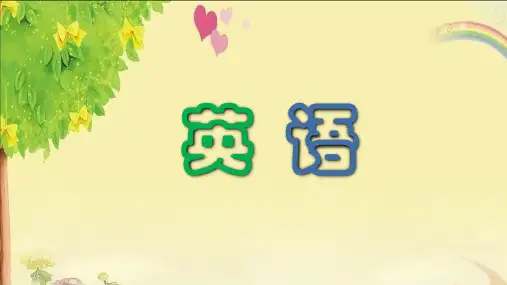
三年级上册英语-Unit1 Hello! join in 剑桥英语
I我 am 是 I’m 我是 I’m Amy. 我是Amy。
三年级上册英语-Unit1 Hello! join in 剑桥英语
三年级上册英语-Unit1 Hello! join in 剑桥英语
打招呼时
Hello! 你好! Hi! 你好! Good morning! 早上好!
I’m…
我叫。。。
三年级上册英语-Unit1 Hello! join in 剑桥英语
三年级上册英语-Unit1 Hello! join in 剑桥英语
What’s 是什么 What 什么 your 你的
is 是 name 名字
What’s your name? 你叫什么名字?
三年级上册英语-Unit1 Hello! join in 剑桥英语
Part 1 用hi ,hello打招呼 Part 2 介绍物品
三年级上册英语-Unit1 Hello! join in 剑桥英语
三年级上册英语-Unit1 Hello! join in 剑桥英语 三年级上册英语-Unit1 Hello! join in 剑桥英语
Part 1
三年级上册英语-Unit1 Hello! join in 剑桥英语
三年级上册英语-Unit1 Hello! join in 剑桥英语
Hello, I’m Daming. What’s your name?
Hello ,Daming! I’m Sam.
三年级上册英语-Unit1 Hello! join in 剑桥英语
三年级上册英语-Unit1 Hello! join in 剑桥英语
Part 2
三年级上册英语-Unit1 Hello! join in 剑桥英语
剑桥版 英语 三年级上册 全册课件
>>Homework
• 1. 回家与爸爸妈妈玩“听指令, 做动作”的游戏。
• 2. 登陆优教同步学习网,听课本 第3页2a部分录音3遍。
close
Starter unit
第3课时
Part 3
>>Lead-in
• Let’s learn.
Stand up.
>>Presentation
• Let’s learn.
Sit down.
>>Presentation
• Let’s learn.
Slap hands.
>>Practice
Listen and mime.
1、老师说指令,同学们做动作。 2、我是小老师,我能说指令,其他
• Let’s learn.
liosotken and
>>Presentation
• Let’s learn.
colour
>>Presentation
• Let’s learn.
lciosltoeunr and
>>Presentation
• Let’s learn.
lwisrtiteen and
>>Practice
Listen and point.
Open your book. Turn to page 4.
>>Consolidation
Colour the frames.
draw
>>Summary
Flashcard.
三年级上册剑桥英语
Unit1单词aunt uncle daughter granddaughter son grandson parents grandparents sister brother cousinplaying a game reading playing football painting taking a photo straight直的 short短的 long 长的 fair金黄色的 quiet安静的funny有趣的 curly弯曲的 naughty淘气的 clever聪明的 small小的big 大的 beard络腮胡 moustache八字胡 doctor医生 farmer农民doctor医生 about关于 science科学句子Grandma’s quiet.Dotty’s naughty.She’s clever.She wants to be a doctor.Suzy wants to give her dog a bath.He loves riding his bike.She doe sn’t like having baths.She loves painting.she enjoys reading about science.※want to+动词原形※love/like/enjoy+动词ingUnit2单词house flat lift village country town cityplants绿植 basement 地下室 balcony 阳台 garden 花园 floor地板/楼层 stairs 楼梯 go upstairs上楼 go downstairs 下楼move house搬家 new address新地址naughty cat淘气的小猫 I don’t think so我认为不是这样的A house in the village A flat in the town1.We live in a flat in a big city. It’s got a balcony and a lift.2.We live in a house in a small village. It’s got two floors and a big garden, but it hasn’t got a basement.数字:one two three four five six seven eight nine ten eleven twelvethirteen-thirty fourteen-forty fifteen-fifty sixteen-sixty seventeen-seventy eighteen-eighty nineteen-ninety one hundred一百two hundred二百1.What’s your name?My name is LiMing.2.Where do you live?你住哪儿?I live in a house in a small village.3.What’s your address?你的地址是什么?It’s 55 Xingfu Road.4.What’s your phone number?你电话号码是多少?It’s 1234567890.Unit3单词wake up醒来 get up起床 put on=get dressed穿上 take off=get undressed 脱下 have a shower=have a bath洗澡 go to bed上床睡觉 wash hands 洗手/face洗脸/hair洗头/feet洗脚/clothes洗衣服 catch a bus乘公交车do my homework做我的作业 take me to school带我到学校 go out to play 出去玩 have breakfast吃早饭 have lunch吃午饭 have dinner吃晚饭lessons start上课 go shopping去购物 go swimming去游泳 go fishing 去钓鱼 listen to music听音乐 read comics看漫画书 ride a bike骑自行车after school放学后 in the morning在早上 in the afternoon在下午 in the evening在晚上 on the way在路上1.What time is it?=What’s the time?现在几点了?It’s seven o’clock. 7:00It’s seven thirty o’clock.=It’s half past seven o’clock. 7:302.What do you do before breakfast?早饭之前你做什么?I have a shower before breakfast.3.What do you do after dinner?晚饭之后你做什么?I read books after dinner.4.What time does he do his homework? 他几点做作业?He does his homework at eight o’clock in the evening.星期Monday Tuesday Wednesday Thursday Friday Saturday Sunday weekday工作日 weekend周末 one week一个星期1.What day is it today? 今天星期几?It’s Monday.2.What’s the date today? 今天几月几号?It’s Nov.27th .时间频率副词always总是 sometimes有时 never从不 every day每天3.How often do you watch TV?I watch TV every day. 我每天都看电视。
剑桥少儿英语三级上册unit
目录
• Teaching objectives • Teaching content • Teaching method • Teaching evaluation • Teaching Reflection
helping students understand the meaning of words in different contexts, such as the usage of "go" and "come" in different situations
Phrasal verbs
introducing common Phrasal verbs and their meanings, e.g., "put on," "take off," "turn on," etc
Developing metacognitive skills
Help students develop metacognitive skills, such as self-monitoring, self-regulation, and self-evaluation, which will support their learning in the long term
Utilize games to make language learning more enjoyable and engaging for students
Design games that require students to use the target language to complete challenges, solve puzzles, or compete against each other
剑桥(join in)版三年级英语上册教材分析
教学目标
能用Good morning. Hello.相互致以简单 的问候。 能用How are you today? I’m fine./ I’m OK. 相互问候。 能用Goodbye.道别。 能用What’s your name? I’m…相互交流 简单的个人姓名信息。
能根据指令 Stand up. Say“Hello”.Slap hands. Sit down.做动作、给图片标号。
课时划分建议
单元 Starter Unit
课时 2课时
具体安排
Period 1: 1. Let’s begin our class. / 5. Meet your new friend. Period 2: 2. Listen and mime. Listen and number.
3. Listen and sing the song. Colour the frame. 4. Listen and point.
课程教学目标要求
一级 听做
1.能根据听到的词句识别 或指认图片或实物。 2.能听懂课堂简短的指令 并做出相应的反应。 3.能根据指令做事情,如 指图片、涂颜色、画图、 做动作等。 4.能在图片和动作的提示下 听懂简单的小故事并做出适当 反应。
说唱
1.能根据录音模仿说话。 2.能相互致以简单的问候。 3.能相互交流简单的个人信息, 如姓名、年龄等。 4.能表达简单的情感和感觉,如 喜欢和不喜欢。 5.能根据表演猜测意思、说出词 语。 6.能学唱英语儿童歌曲和歌谣15 首左右。 7.能根据图、文说出单词或短句。
课标要求
能相互致以简单的问候。
能相互交流简单的个人信 息,如姓名、年龄等。
能根据指令做事情,如指图片、 涂颜色、画图、做动作等。
- 1、下载文档前请自行甄别文档内容的完整性,平台不提供额外的编辑、内容补充、找答案等附加服务。
- 2、"仅部分预览"的文档,不可在线预览部分如存在完整性等问题,可反馈申请退款(可完整预览的文档不适用该条件!)。
- 3、如文档侵犯您的权益,请联系客服反馈,我们会尽快为您处理(人工客服工作时间:9:00-18:30)。
小学三年级起点英语上册Unit2 Numbers 教学设计教学目标:1、能正确认读、规范书写字母Ff,Gg,Hh,Ii,Jj,Kk,并能感知字母在单词中的发音。
2、能根据听到的数字单词one,two,three,four,five,six,seven,eight,nine,ten,做出相应的手势,并能根据数字认读单词。
3、能根据听到的单词flag,guitar,horse,ice cream,juice,kite指认图片或实物,并能根据图片认读单词。
4、能根据听到的句子What’s your phone number?My number is…正确记录电话号码,并能相互交流简单的电话号码信息。
5、能在图片和动作的提示下听懂、学说歌谣The tiger jump,并正确指认图片和做出相应的动作。
6、能在图片的提示下听懂、读懂小故事The snails,并能进行简单的角色表演。
7、能在老师的指导下用英语做猜数的游戏,并在游戏中进行简单的交际。
如What’s in the box?Crayons?Yes, How many?Seven. No/Yes.教学内容:Part 1a、Part 1b、Part 2a、Part 2b、Part 3a、Part 3b、Part 4a、Part 4b、Part5、Part6、Part7。
课时:四课时第一课时教学内容:学习2a、2b、1a、1b四个部分。
教学目标:1、知识目标认识zero—ten十一个数字,能认、听、说、读。
2、技能目标培养学生听力和模仿能力。
3、情感目标在游戏中学习英语,培养学生的英语学习兴趣和信心。
教学重点:认准读准zero—ten十一个数字单词。
教学难点:创设生动的情景,熟练运用zero—ten这十一个数字单词,进行报数或说数字游戏。
教学准备:课件、手指操、磁带、录音机。
教学流程:第一个环节:Warming-up课堂预热。
Step1:组织学生演唱Unit1的数字歌曲。
Step2:带领学生说one,two,three,four,five,six。
【通过熟悉的歌曲引入新课,既营造轻松愉快的氛围,能使学生很快地集中注意力,同时也为新知的学习作好铺垫。
】第二个环节:Free talk.T:Class begins!Good morning,dear children!Ss:Good morning,dear Miss Tu!T:Nice to meet you!Ss:Nice to meet you,too.T:How are you?Ss:I’m fine,thank you!【通过简单的英语对话进行课前师生问候交流,拉近了师生间的距离,激发了学生说英语的热情,为新进入学习打下了情感基础,同时复习了前面学过的知识。
】第三个环节:Presentation新授Step1:生翻到课本P13,师播放录音,生依次指认数字单词。
【初步感知one—ten等数字单词】Step2:师带生模仿西方人做数字手指操,师生一起边数边做,游戏方法表示one 竖大拇指;表示two再竖食指;表示three把前3个手指都竖起来,依次类推。
表示six,原来那只手张开,把另外一只手的大拇指伸出,依次类推。
【调动学生全身感官,让生在动手、动口、动脑中学习数字单词】Step3:报数,帮助学生操练和巩固数字单词。
【引导学生将刚学的单词运用在实际当中】Step4:引导学生观察几组数字的规律,完成Part2b;写出所缺数字,并共同核对答案。
【培养学生的观察能力和规范抄写能力】Step5:齐读数字,进一步巩固所学数字。
【整体回顾,加强巩固】第四环节:Practice模仿跟唱儿歌The tiger jump.Step1:放映PPT,出现the tiger,Toby,它自我介绍:I’m a tiger,look at me.I’ll show you the tiger jump,然后播放录音,并伴以体态语。
【帮助学生初步接触,形象感知儿歌内容】Step2:生翻到课本P12,引导生仔细观察图片,了解The tiger jump的动作顺序。
Step3:再次播放录音,生边听边模仿跟唱。
Step4:采取多种形式操练,表演儿歌。
老师说数字,生做动作,师做动作,生说数字等。
【师生在音乐中边说边做中加强巩固了zero—ten这十一个数字的听、说、理解和用。
】第五个环节:Homework.1、同桌相互指认zero—ten这十一个数字。
2、正确规范抄写zero—ten,每个单词写3遍。
【学生通过相互指认来检测本堂课学习的效果,结合规范抄写,进一步加强巩固记忆。
】Design板书:zero one two three four five six seven eight nine ten第二课时教学内容:Part3 a and Part 3b.教学目标:1、知识目标:巩固zero—ten十一个数字单词。
2、技能目标:培养学生的听力和记录能力,能根据听到的句子“What’s your(phone)number?My number is…正确记录电话号码,并能相互交流简单的电话号码信息。
3、情感目标:培养学生的沟通交际能力。
教学重点:能相互交流简单的电话号、车牌号、门牌号等信息,用句型What’s your(phone) number?My number is ….教学难点:创设交流情景。
教学准备:数字接龙、电话号码对对碰录音。
教学流程:第一环节:Free talk 师生问候【联络师生情感,运用已学日常问候语,营造英语学习氛围】第二环节:Warming-up预热全班一起玩数字接龙游戏。
【进一步熟悉、复习数字单词,为后面的听音写电话号、车牌号、门牌号作准备】第三环节:New teaching 新授Step1:请生翻到课本P14。
问:What are the children’s names?引导生看图;教读三个孩子的名字:Alice,Paul,Lisa。
Step2:通过图片和实物,向学生介绍单词Phone并教读。
Step3:播放录音,要求生拿出笔,仔细听,快速记录下三个孩子的电话号码。
Step4:再放录音,学生自己核对答案。
Step5:全班一起核对答案:一名学生用英语说号码,师记录,其余生核对,并大声朗读出来;或请一名学生到黑板上写下三个号码,并大声读出来,其余学生核对。
【采用多种形式,让学生作为学习的主体参与其中,充分调动学生学习的积极性和主动性。
】Step6:师生学自制名片,自我介绍:My phone number is…重复几遍,让学生感知连续说数字时如何停顿,并保证学生能够理解并模仿,然后提问:What’s your phone number?引导生在书上写下自己的电话号码,尝试模仿老师;说:My phone number is…。
Step7:Teach new sentences玩小游戏,电话号码对对碰,教学操练新句型。
What’s your (phone) number?——My (phone) number is….两人一组,一个学生报自己的电话号码,说:My phone number…另一个学生迅速记录下来,然后核对。
【设计对话情景和小游戏,让学生在创设情景中乐于学习和交流。
】第四环节:Practice操练Step1:师出示一份通讯录,与学生示范对话:T:What’s your phone number?S:My phone number is …(师在通讯录上记录下来)。
Step2:学生初步理解和感知后,引导学生说和练习问句。
What’s your phone number?Step3:通过小组活动,学生自己回答和记录电话号码。
Step4:根据时间允许,可开展一些关于number的拓展活动,如询问记录、门牌号、车牌号、QQ号等。
【让学生通过反复练习听和说,由不熟到熟,化难为易,熟练运用句型“What’s your phone number?My number is…”.第五个环节:Homework.搜集几个生活中特殊的电话号码,匪警号(110)、火警号(119)、急救号(120)等。
【让学生结合实际生活,感受数字在生活中存在的广泛性和重要性。
】第三课时教学内容:Part 4a、Part 4b、Part 5a、Part5b。
教学目标:1、知识目标:①认准、读准,规范书写字母Ff,Gg,Hh,Ii,Jj,Kk。
②认读单词F flag,G guitar,H horse,I ice cream,J juice,K kite.2、能力目标:初步培养学生观察能力和模仿能力。
3、情感目标:通过游戏等有趣活动教学,培养学生学英语的浓厚兴趣。
教学重点:让学生学会认、读、规范书写字母Ff,Gg,Hh,Ii,Jj,Kk及以它们开头的单词。
教学难点:在教授中,寓教于乐,循序渐进,降低学生学习英语的坡度。
教学准备:课件、字母卡、图片、悄悄话游戏、录音。
教学流程:第一个环节:Free talk 师生问候【师生联络感情,营造英语课堂气氛。
】第二个环节:Warming-up预热。
Step1:播放字母歌,学生跟唱。
【让学生能在轻松愉快的氛围中作好上课准备,还能为下面的新授作准备。
】Step2:出示字母卡Aa、Bb、Cc、Dd、Ee,开火车认读【复习巩固】。
第三个环节:New teaching新授。
Step1:请生翻到课本P15,放录音,生边听边指认字母Ff,Gg,Hh,Ii,Jj,Kk,初步感知字母读音。
Step2:再放录音,生跟读,模仿字母读音。
Step3:师可通过大声、小声、无声、学生带读及不同形式教授字母。
让学生观察口型,学习正确发音。
Step4:游戏中练习。
组织全班同学玩“字母接龙”和“看口型猜字母”。
Step5:师多次播放录音,生手指字母,感知几组字母Aa、Hh、Jj、Kk、Ee、Bb、Cc、Dd、Gg、Ii、Ff的读音规律。
【通过形式多样的认读方式,学会这几个字母,让学生没有枯燥乏味的感觉。
】第四个环节:New teaching the new words.Step1:师重复播放录音,生指认字母和对应的单词,并跟读。
Step2:借助图片呈现单词:flag,guitar,horse,ice cream,juice,kite引导学生:1)听单词的读音,指认图片;2)看图片说出单词;3)根据单词指认图片。
【用图片和实物的方法引导学生理解单词。
】第五个环节:Practice 操练组织全班学生一起玩“悄悄话游戏”。
【采用学生喜欢的方式,对整节课所学的字母和单词进行进一步的操练和巩固。
】第六个环节:Work课堂作业1、学生打开课本,自己认读字母并观察字母的印刷体和书写体,以及字母的书写格式。
